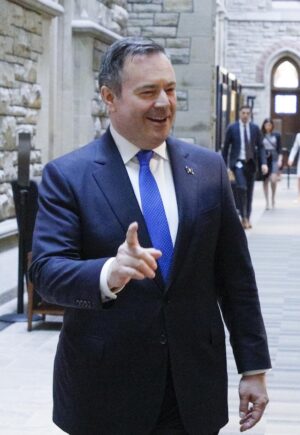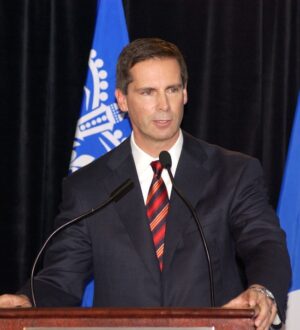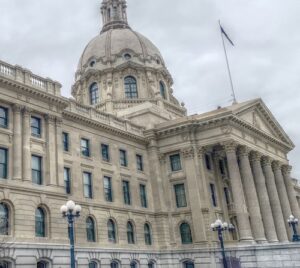
In 2023, Christopher Dougherty received the H. Woods Bowman Student Award from ARNOVA for preliminary results from his dissertation research.
Recently, Christopher Dougherty completed research that asks, “How does government funding for charities change when the party in power changes?” His answer is based on data sets covering the provinces of Ontario and Alberta from 2003 to 2017. In a PhD dissertation, he analyzed changes in electoral district representatives and governments, looking at which nonprofits gained new funding and which lost funding — and the extent to which the changes reflected the interests of new governments. Dougherty spoke to PANL Perspectives about his findings.
Question: What inspired you to tackle this study about government funding of charities?

The Allan Inquiry into environmental charities, under the Jason Kenney government in Alberta, cost taxpayers $3.5 million and concluded that environmental groups had done nothing wrong, aside from raise awareness about climate change — and a few charities sued for defamation afterwards. Photo is courtesy of Andre Forget.
Christopher Dougherty: About half of all revenue for the charitable sector in Canada comes from federal, provincial and municipal governments, and governments can be quite vocal about which charities they want to support and which they don’t want to. I’m originally from Alberta, so the Allan Inquiry into environmental charities, under the Jason Kenney government, was top of mind, as were the Stephen Harper-era, political-activities audits by the Canada Revenue Agency.
There’s also the ongoing debate about whether charities that oppose policies of the Justin Trudeau government should be eligible for Canada Summer Jobs Grant funding. So, I wanted to see how governments move charity funding around to match their policy and political goals.
Q: You write that in Ontario, changes in funding reflect partisan identity as governments and local representatives change. Can you give examples of this — or explain what you mean?

After the Dalton McGuinty government was elected in Ontario in 2003, Jewish religious charities, social services, health, animal welfare, and parks and environment all saw cuts that year or the year after the change in provincial government.
Christopher Dougherty: When there’s a new federal government, charities in Ontario see some of the biggest changes in funding. When I add together all of the federal government revenue to charities in electoral districts (excluding hospitals and post-secondary schools), they receive 27% more funding in a new government’s first year, when controlling for other variables. When I looked at a sub-sector, instead of an electoral district, new federal governments grant more to Ontario charities that are in the post-secondary education sub-sector, ‘other’ religious (not Christian, Muslim or Jewish) sub-sector, and social services sub-sector. Since post-secondary and social services are both provincial responsibilities, federal spending in these sub-sectors indicates something beyond direct program spending.
While new federal governments increase spending to some sectors after being elected, new provincial governments tend to cut spending. In Ontario, Jewish religious charities, social services, health, animal welfare, and parks and environment all saw cuts in the year or in the year after the 2003 change in provincial government, when controlling for other variables.
Q: In Alberta, there’s less change in funding to charities around elections and changes in government. Is there an example of this?

Read “Do Private Family Foundations Engage in Political Activities Through Their Granting?” by Christopher Dougherty.
Christopher Dougherty: Alberta sees far fewer changes and smaller changes to its funding following elections and changes in government. The biggest changes are increases to Christian religious charities and missionary religious charities in election years and in a new government’s first year. Funding changes in other sub-sectors involve smaller numbers of charities, so the changes might not be due to big patterns and are likely because of changes involving individual charities.
Q: You write, “The combined results show that the charitable sector is indeed an outlet for aggregating and expressing collective identities, but that the degree to which this happens depends on the political context.” What to you mean?

Samantha Zuhlke, a prof at the University of Iowa, found that politicians in the US use charities to access constituencies and political power. Canadian politicians seem to be doing the same thing.
Christopher Dougherty: One of the interesting things in these results is that elections, new governments, and electoral district competitiveness seem to be behind a lot of the changes in charity funding. The party that forms government, the party representing an electoral district, and whether an electoral district is in government or opposition all seem to matter less.
For me, this suggests that politicians use charity funding to achieve political goals: gaining or keeping power. Jane Jenson wrote more than 30 years ago that politics is about creating constituencies and building support for collective identities, which charities do, and Samantha Zuhlke found in the US that politicians use charities to access constituencies and their political power. Canadian politicians seem to be doing just that—trading funding (or the promise of funding) to constituencies represented by charities in exchange for votes. And, they are doing this more in electoral districts that are more politically competitive and that are located in more competitive parts of the country (in Ontario, for example, compared to Alberta).
Q: Did anything surprise you in this study related to charity revenue and government?
Christopher Dougherty: The degree to which federal government funding changes for charities in the post-secondary, hospital, and social services sub-sectors was surprising, because each of these sub-sectors is in an area of provincial responsibility. It will be important to take a closer look at what’s happening here.
The other surprising finding was the role of religious charities in the results. It’s not clear, in the data set, which funding is going to congregations and which funding is going to religiously-affiliated service charities, and that needs a closer look.
Overall, the results suggest some interesting trends, and I plan to look at other provinces to see if these trends show up in other places with different political situations.
Christopher Dougherty has PhD in Public Policy from the School of Public Policy and Administration and he completed a Master of Philanthropy and Nonprofit Leadership (MPNL), both at Carleton University. His research focuses on the charitable sector in Canada. He’s currently a Visiting Scholar at the Business School of the University of St Andrews, in the UK. He can be found on LinkedIn.
Thursday, November 14, 2024 in Alum Story, For homepage, Fundraising, General, News & Events, Public Policy & Advocacy, Research from Alumni
Share: Twitter, Facebook



